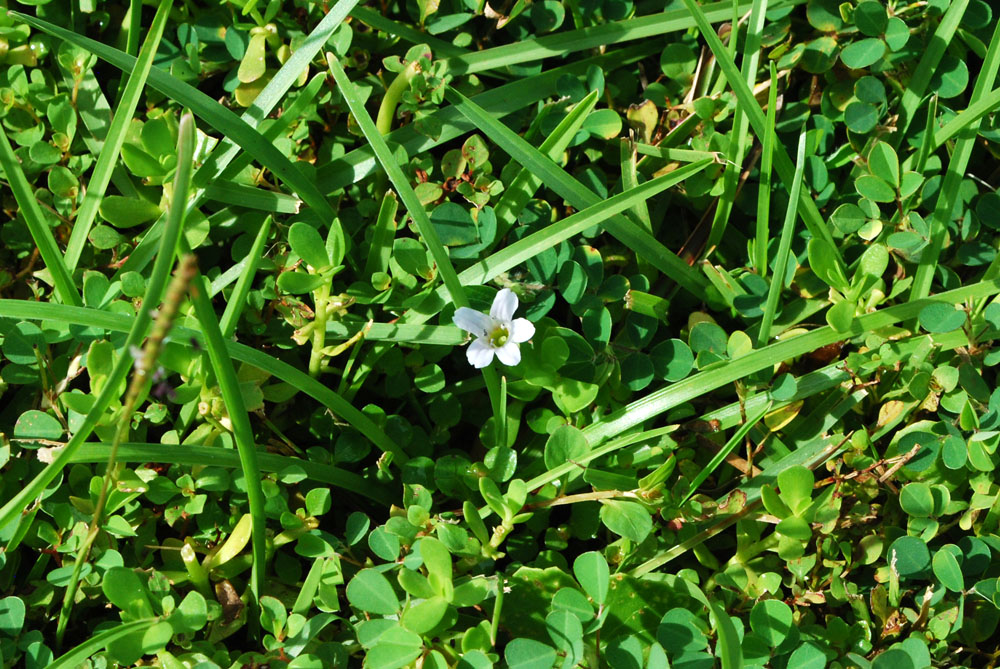Bacopa monnieri
| Bacopa monnieri | |
|---|---|

| |
| Photo by Wayne Matchett, SpaceCoastWildflowers.com | |
| Scientific classification | |
| Kingdom: | Plantae |
| Division: | Magnoliophyta - Flowering plants |
| Class: | Magnoliopsida - Dicotyledons |
| Order: | Scrophulariales |
| Family: | Scrophulariaceae |
| Genus: | Bacopa |
| Species: | B. monnieri |
| Binomial name | |
| Bacopa monnieri (L.) Pennell | |

| |
| Natural range of Bacopa monnieri from USDA NRCS Plants Database. | |
Common names: Herb of grace; Monnier's water-hyssop
Contents
Taxonomic notes
Synonym: Bramia monnieri (Linnaeus) Drake. [1]
Varieties: None.[1]
Description
The B. monnieri plant has no smell. The erect portion of the stem is 10 - 30 cm tall and is glabrous. The leaves are obovate in shape, 6 - 17 mm long, 3 - 8 mm wide, and only have a single vein (rarely 2-3 veins). The internodes are longer than the leaves. The pedicel is longer than the subtending leaf. The bractlets are present. The largest sepals grow up to 5 - 7 mm long, and 3 - 4 mm wide. The flower is white in color and sometimes tinged with blue and is rotate to regular, growing up to 8 - 10 mm long. The lobes grow to the same size as the tube. There are 4 stamens which are subequal.[2]
Distribution
Ecology
Habitat
In the Coastal Plain in Florida, B. monnieri has been found in shallow water of a shaded ditch; with Eleocharis flavescens in muck of small floating island in a ditch; sand fill near a salt marsh; and shallow brackish water.[3]
Phenology
B. monnieri has been observed to flower in June and July and fruit in June.[3][4] Other sources say the plant flowers from April to frost.[2]
Pollination
Bacopa monnieri has been observed at the Archbold Biological Station with sweat bees from the Halictidae family such as Lasioglossum pectoralis, and L. puteulanum and leafcutting bees from the Megachilidae family such as Megachile brevis pseudobrevis, and M. georgica.[5]:
Conservation, cultivation, and restoration
Cultural use
Photo Gallery
References and notes
- ↑ 1.0 1.1 Weakley, A.S. 2015. Flora of the southern and mid-atlantic states. Working Draft of 21 May 2015. University of North Carolina at Chapel Hill, Chapel Hill, North Carolina.
- ↑ 2.0 2.1 .Radford, Albert E., Harry E. Ahles, and C. Ritchie Bell. Manual of the Vascular Flora of the Carolinas. 1964, 1968. The University of North Carolina Press. 580-2. Print.
- ↑ 3.0 3.1 Florida State University Robert K. Godfrey Herbarium database. URL: http://herbarium.bio.fsu.edu. Last accessed: July 2015. Collectors: Loran C. Anderson, Karen MacClendon, Travis MacClendon, R.A. Norris, P.L. Redfearn Jr., Nia Wellendorf. States and Counties: Florida: Calhoun, Jefferson, Taylor, Wakulla. Compiled by Tall Timbers Research Station and Land Conservancy.
- ↑ Nelson, G. PanFlora: Plant data for the eastern United States with emphasis on the Southeastern Coastal Plains, Florida, and the Florida Panhandle. www.gilnelson.com/PanFlora/ Accessed: 7 DEC 2016
- ↑ Deyrup, M.A. 2015. Database of observations of Hymenoptera visitations to flowers of plants on Archbold Biological Station, Florida, USA.